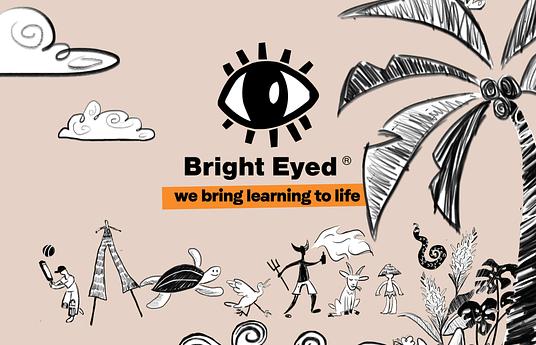For example, Story Arts recognises the power of storytelling and collaborates with entertainment industry experts into the classroom to teach the fundamentals of storytelling. They give students the opportunity to practice real world storytelling challenges in film, TV, gaming, UX design, branding, marketing, acting and more.
Students that participate in Story Arts become more engaged in the classroom, and develop their critical thinking and career readiness. They not only become well-equipped to enter the media industry, but also develop a strong foundation in the art of storytelling - a transferable skill that can also be used in other domains.

Students participating in Bright Eyed Workshop
But it is also important to keep in mind whose stories are being told. Bright Eyed, an innovation based in Trinidad and Tobago, aims to empower Caribbean children using stories “about us, told by us”. Through stories, eco-education activities, and immersive exhibitions, they aim to make every child feel seen, heard, and valued by providing media that reflects their world and experiences.
Our children deserve to see themselves as heroes, not victims.
"Our children deserve to see themselves as heroes, not victims. Bright Eyed flips the script, weaving our rich Caribbean culture into every story and immersive experience—because we’re focused on building pride, not hand-me-down trauma,” explains Jeunanne Alkins, Founder of Bright Eyed.

Child reading Bright Eyed picture book, "The Most Magnificent!"
Bright Eyed’s content works to decolonise the perspective of content in the Caribbean Primary Curriculum so that children take pride in their natural and cultural capital. They hope that this encourages families to continue to explore their culture and engage in discussions about what exists around them, especially in their community.
Storytelling can also be used to promote student agency and growth. My Learning Story is a dynamic tool that allows learners to document evidence of their growth and curiosity. Through pre-assessments and reflections, it helps learners organise their prior knowledge, explore questions, and showcase milestones, culminating into a compelling video story of personal growth.

Learner thinking about what to write in "My Learning Story" - This is what I think I know about science
Annette De Graaf, a former foreign language educator at the International School of Amsterdam and founder of Flow School Norway, created “My Learning Story” based on her deep conviction that education should be a deeply personal and transformative journey for every learner. This approach gives learners ownership of their learning experiences by allowing them to progress at their own pace and document their insights and achievements.
It not only empowers learners to feel seen, heard and valued, but also gives educators and parents valuable transparency into how each individual learns and grows.
“My Learning Story fosters ownership at every stage of a learner’s journey. By documenting their unique prior knowledge and curiosities, it sparks engagement and cultivates intrinsic motivation to take charge of what comes next: researching answers to their big questions, organizing their learning and growth, presenting and sharing their discoveries as well as reflecting on their personal progress. It not only empowers learners to feel seen, heard and valued, but also gives educators and parents valuable transparency into how each individual learns and grows,” explains Annette.
Learn more about these innovations and others in the latest Global Collection report!
Working on something yourself? Share your idea with us!

